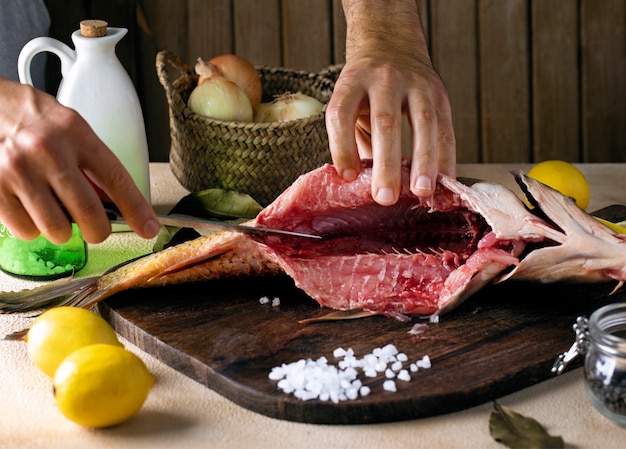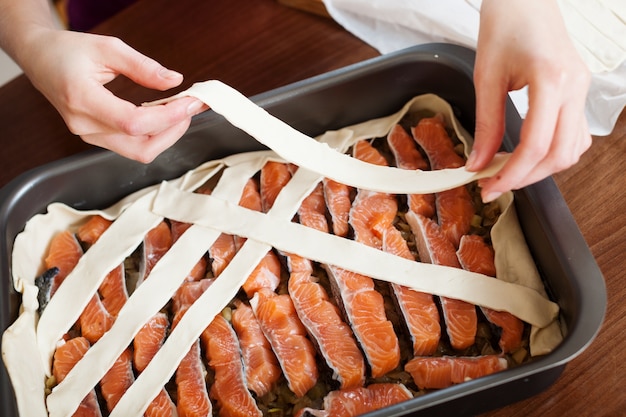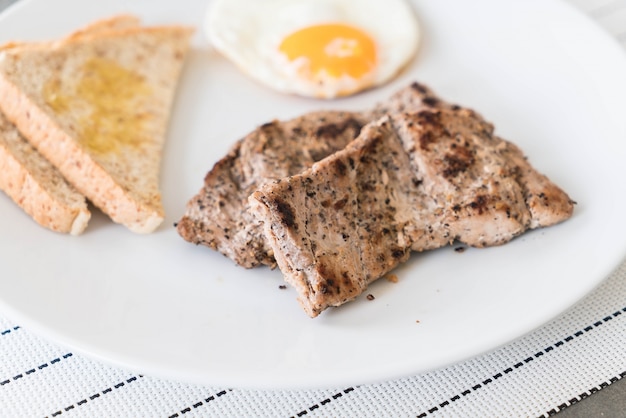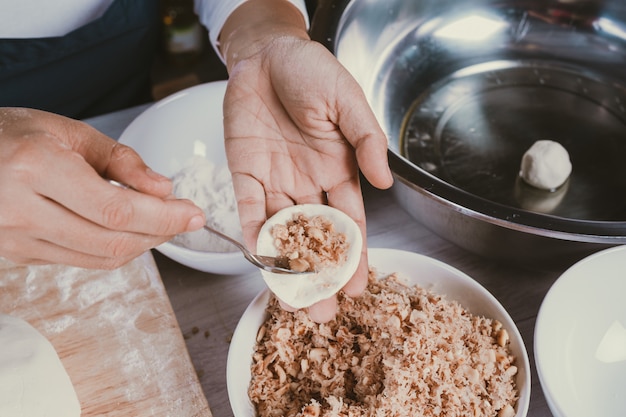Ah, corned beef brisket. Just the name conjures up images of warm kitchens, comforting aromas, and hearty family meals. It's a dish that's been a staple in my family for generations, and I've spent countless hours perfecting my own take on this classic. From understanding the different cuts of brisket to the art of brining and slow cooking, there's a whole world of knowledge to unlock when it comes to mastering this delicious dish. So, grab a cuppa, settle in, and let's dive into the ultimate guide to creating a truly tender and flavorful corned beef brisket.
Part 1: Understanding the Brisket

The foundation of any great corned beef brisket is, of course, the brisket itself! This cut of beef, taken from the chest of the animal, is known for its marbling - those beautiful streaks of fat that melt during cooking, adding both tenderness and flavour. Now, there are two main types of brisket, each with its own distinct characteristics:
The Point
Think of the point as the more decadent side of the brisket. It's got a higher fat content, which renders down during cooking, resulting in an incredibly juicy and flavorful brisket. If you're a fan of rich, deep flavours, the point is the way to go. It's perfect for those who love their meat tender and succulent, practically falling apart with every bite.
The Flat
The flat is the leaner cousin of the point. It's got less fat, making it a bit less juicy but still undeniably delicious. It's ideal for those who prefer a leaner cut or for slicing thin for sandwiches. While it might not be as melt-in-your-mouth tender as the point, it's still incredibly flavorful and holds its shape well, making it perfect for those delicate slices.
When choosing your brisket, look for one that has a good amount of marbling throughout, especially if you're going for the point. A fresh, vibrant colour and good packaging are also key indicators of quality. And don't be shy about asking your butcher for advice. They're a wealth of knowledge and can help you pick the perfect brisket for your needs.
Part 2: The Art of Brining: Infusing Flavor and Tenderness

Now, we come to the magic of brining. This is where the real transformation begins, where the humble brisket becomes a flavour-packed masterpiece. Brining is essentially soaking the brisket in a salt-based solution that infuses it with flavour and moisture. It's a crucial step, as the salt breaks down the tough muscle fibers, making the brisket unbelievably tender. You can buy pre-brined briskets, but let me tell you, there's nothing quite like creating your own brine and experiencing the joy of customizing the flavour.
A Basic Brine Recipe
Here's a simple brine recipe that I've used for years, and it never fails to impress:
Ingredients:
- 1 gallon (3.78 litres) cold water
- 1 cup (240 ml) kosher salt
- ?? cup (120 ml) brown sugar
- 2 tablespoons black peppercorns
- 2 bay leaves
- 1 teaspoon whole allspice
- 1 teaspoon juniper berries
Instructions:
- In a large container, combine the water, salt, and brown sugar, stirring until the salt and sugar fully dissolve.
- Add the peppercorns, bay leaves, allspice, and juniper berries.
- Carefully place the brisket in the brine, making sure it's completely submerged. It's best to use a container that's just large enough to hold the brisket, ensuring it's comfortably surrounded by the brine.
- Cover the container and refrigerate for 5-7 days, turning the brisket every day. This helps ensure that the brine evenly penetrates the meat.
Remember, this is just a starting point. Feel free to experiment with different spices and add-ins to create your own unique brine. A few cloves of garlic, a sprinkle of coriander seeds, or a touch of smoked paprika can really elevate the flavour profile. Just remember to adjust the quantities to your taste.
Part 3: Slow Cooking: The Key to Tenderness

After the magic of brining, it's time to start the slow, deliberate process of cooking your brisket. This is where patience truly shines. It's a marathon, not a sprint, and the slow, gentle cooking allows the collagen to break down, transforming the brisket into a melt-in-your-mouth delight. Now, let's explore the two methods I find most effective for slow cooking:
slow cooker: Hands-Off Convenience
The slow cooker is the ultimate hands-off approach to cooking a brisket. It's perfect for those busy days when you want to simply set it and forget it. Just place the brisket in the slow cooker, pour in a couple of cups of water or beef broth, and let it cook on low for 8-10 hours, or until it's incredibly tender. The slow cooker does all the work for you, releasing the delicious flavours and making for an incredibly tender and juicy brisket.
dutch oven: The Classic Approach
For a more traditional method, a Dutch oven is an excellent choice. Start by browning the brisket on all sides in the Dutch oven over medium heat. This creates a beautiful crust that locks in the juices and adds a wonderful depth of flavour. Once it's browned, add a cup or two of beef broth, a couple of bay leaves, and a few peppercorns. Cover the pot tightly and transfer it to the oven. Cook it low and slow at 300°F (150°C) for 5-7 hours, or until the brisket is fork-tender. This method is a bit more hands-on, but the results are absolutely worth the effort.
Whichever method you choose, remember the key is slow and steady. Don't rush the process, as the slow cooking allows the magic to happen, resulting in a truly tender and flavorful brisket.
Part 4: The Perfect Sides: Elevating Your Meal
No corned beef brisket meal is complete without the perfect sides. These are the supporting actors that complement the rich, savory flavour of the brisket and create a well-rounded culinary experience.
Classic Accompaniments
- Cabbage: braised cabbage with a hint of bacon or smoked sausage adds a delightful sweetness and a satisfying crunch. It's the perfect complement to the rich flavour of the brisket.
- Carrots: Roasted or steamed carrots with a touch of butter and herbs provide a simple but delicious side, adding a touch of sweetness and freshness to balance the saltiness of the brisket.
- mashed potatoes: fluffy mashed potatoes with a dollop of sour cream are a classic pairing that soaks up all the delicious juices from the brisket, creating a comforting and satisfying combination.
- pickled beets: The tangy sweetness of pickled beets cuts through the richness of the brisket, providing a refreshing contrast that enhances the overall flavour profile.
- Pickles: Dill pickles or bread and butter pickles are a must-have, balancing out the salty flavour of the corned beef and adding a tangy punch that elevates the entire meal.
Of course, no corned beef brisket meal is complete without a good dollop of mustard. A classic yellow mustard is always a winner, but don't be afraid to explore other options like a spicy brown mustard or a tangy Dijon mustard. It's all about finding what you enjoy!
Part 5: The Art of Slicing: Unveiling Your Masterpiece
After all that slow cooking and patience, you're finally ready to unveil your masterpiece. But before you dig in, there's one final step: slicing the brisket. It's a critical part of the process, affecting the texture and overall enjoyment of your brisket. So, take your time and let's get this right.
Slicing Techniques
The key to slicing a brisket is to cut against the grain. Imagine the muscle fibers running in a particular direction. You want to cut perpendicular to those fibers, which will make the meat easier to chew and result in a more tender and juicy bite.
- Use a sharp knife: A sharp knife is essential for clean, even slices. A dull knife will only tear the meat, making it difficult to cut and resulting in uneven pieces.
- Cut against the grain: Always cut perpendicular to the muscle fibers, slicing across the grain rather than following it. This will make a big difference in the texture of your brisket.
- Slice thin: For sandwiches, slice the brisket thinly, allowing for a tender and flavorful bite. For a more rustic presentation, you can slice it a little thicker.
Once your brisket is sliced, you can arrange it beautifully on a platter, surrounded by your chosen sides. Encourage everyone to pile their plates high with the tender, juicy meat, and don't forget to drizzle some of the delicious cooking juices over the top. It adds an extra layer of flavour and moisture, making for a truly satisfying meal.
Part 6: Mastering the Leftovers: Delicious Second Acts
Let's face it, corned beef brisket is a dish that practically begs for leftovers. And don't even think about wasting them! There's a whole world of delicious possibilities waiting to be explored with those leftover bits of brisket.
Classic corned beef sandwiches
The most obvious choice? Corned beef sandwiches! Pile your favorite bread with thinly sliced brisket, sauerkraut, Swiss cheese, and a dollop of mustard. It's the perfect lunch or a quick and satisfying dinner. You can even add a little Thousand Island dressing for an extra kick.
Hearty Corned Beef Hash
For a hearty breakfast or brunch, try making corned beef hash. Simply dice the leftover brisket, fry it up with diced potatoes and onions, and season with salt and pepper. You can even add a sprinkle of paprika for a touch of colour and flavour. It's a classic for a reason!
Comforting corned beef soup
If you're feeling a little chilly, a comforting corned beef soup is the perfect answer. Combine leftover brisket, broth, diced potatoes, carrots, and celery for a warm and satisfying meal. Add a dollop of sour cream or a sprinkle of fresh herbs for an extra touch. It's the ultimate comfort food for those cold winter days.
Part 7: FAQs: Answering Your Burning Questions
Now you're armed with all the knowledge you need to create a spectacular corned beef brisket. But before you get started, I'm sure you have a few questions. Let's tackle those together.
1. Can I Substitute the Brine?
You can definitely use a pre-made brine. They're a convenient option, and many are quite good. But I always recommend making your own so you can tailor the flavour profile to your liking. Plus, it's really not that hard! Just follow the recipe I've provided and adjust the spices to your taste. Experiment and find what you love!
2. How Do I Know If My Brisket Is Done?
The best way to tell if your brisket is done is to check the tenderness. It should be fork-tender, meaning it pulls apart easily with a fork. You can also use a meat thermometer to ensure the internal temperature reaches at least 190°F (88°C). If you're using a slow cooker, you can simply check for tenderness after 8 hours, and if it's not quite done, cook it for another hour or two.
3. What If My Brisket Is Too Dry?
Don't worry! A little dryness can easily be fixed. When you slice the brisket, it's a good idea to drizzle some of the cooking juices over the top. This will help to add moisture and enhance the flavour. You can also add a little bit of butter or gravy to the sliced brisket for extra richness. And remember, a little dryness is better than overcooking, which can make the brisket tough.
4. Can I Freeze Leftover Brisket?
Absolutely! leftover corned beef brisket freezes beautifully. Just let it cool completely, then wrap it tightly in plastic wrap and aluminum foil. It should keep well in the freezer for up to 3 months. When you're ready to use it, thaw it in the refrigerator overnight. And don't forget, you can use it in all sorts of recipes, from sandwiches to hash to soups!
5. How Do I Make My Brisket Extra Tender?
Here are a few tips for making your brisket incredibly tender:
- Cook it low and slow: This gives the collagen time to break down, resulting in a tender and juicy brisket. The slower the cooking, the more tender the meat will be.
- Use a meat thermometer: This ensures that the brisket reaches the proper internal temperature for maximum tenderness. A meat thermometer takes the guesswork out of cooking, allowing you to cook the brisket to perfection.
- Rest the brisket: Once it's cooked, let the brisket rest for at least 30 minutes before slicing. This allows the juices to redistribute, resulting in a more tender and flavorful brisket. It's a simple trick that makes a huge difference in the overall texture.
Part 8: Final Thoughts
There you have it, my friends! The ultimate guide to tender, flavorful corned beef brisket. It's a dish that requires a little time and patience, but trust me, the results are worth it. So, gather your ingredients, put on your favourite tunes, and get ready to create a culinary masterpiece that will impress everyone at your table. Happy cooking!
Everyone is watching

How to Cook Frozen Lobster Tails Perfectly: A Step-by-Step Guide
RecipesLobster. Just the word conjures up images of lavish meals, special occasions, and a taste of luxury. But let's...

Pigs in a Blanket Cooking Time: How Long to Bake for Perfect Results
RecipesAh, pigs in a blanket. Just the name conjures up images of those delightful little parcels of crispy pastry en...

Pork Fillet Cooking Time: How Long to Cook It Perfectly
RecipesPork fillet, or tenderloin as it's sometimes called, is a real favourite in our house. It's so versatile, and...

The Ultimate Guide to Cooking Delicious Frankfurters
RecipesLet's face it, we all love a good frankfurter. It's a classic, simple, and always satisfying. But let's be rea...

The Ultimate Guide to Tender, Juicy Pulled Pork
RecipesRight, let's talk pulled pork. It's one of those dishes that just screams "comfort food," doesn't it? I mean...
